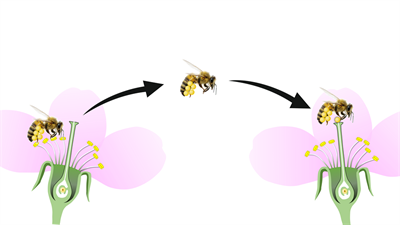
PUMPA - SMART LEARNING
எங்கள் ஆசிரியர்களுடன் 1-ஆன்-1 ஆலோசனை நேரத்தைப் பெறுங்கள். டாப்பர் ஆவதற்கு நாங்கள் பயிற்சி அளிப்போம்
Book Free DemoThe transfer of pollen grains from the anthers of a flower to the stigma of a flower on another plant of the same species is known ascross pollination.

Cross-pollination
In unisexual flowers, cross-pollination is unavoidable. Nature favours cross-pollination in bisexual flowers as well.
Advantages of cross-pollination:
- Cross-pollination results in the formation of new varieties because the seeds produced by cross-pollination develop and germinate into better plants.
- Comparatively, more viable seeds are produced.
- Offspring can be healthier and disease resistant.
Disadvantages of cross-pollination:
- There are high chances for pollination failure due to the distance barrier.
- Pollen grains are wasted in high amounts.
- Cross-pollination may result in the generation of unwanted characters.
- It depends on external factors for pollination.
- Flowers should have bright-coloured petals, long stamen and pistils, fragrance, or they should produce nectar to attract the pollinating agents.
Agents of cross-pollination:
- Biotic agents (zoophily): These agents are living organisms.
- Abiotic agents: Non-living factors act as agents.
Biotic agents | Pollination (Zoophily) |
| Insects | Entomophily |
| Birds | Ornithophily |
| Bats | Chiropterophily |
| Snail | Malacophily |
Abiotic agents | Pollination |
| Wind | Anemophily |
| Water | Hydrophily |
The type of pollination in which transfer of pollen grains occurs by living organisms such as insects, birds, bats and snails is known as biotic pollination.